Preventing Patient Centricity from Becoming a Fad
Applied Clinical Trials
This three-step process can help managers accurately assess how patient-centric their trials really are.

Patient centricity is a popular trend with the potential to revolutionize clinical trials. By shifting from a product-focus to a patient-focus, clinical trials will become more relevant, less costly, and more impactful.1 Patient centricity has the potential to be “biopharma’s Holy Grail” that will lead to a “renaissance” in clinical research.2,3
But will patient centricity ever reach its full potential? Skeptics are beginning to speculate that this approach is simply another fad.4 According to this view, patient centricity applies new jargon to standard clinical trial processes that result in high-visibility but low-impact activities.5,6 They admit that patient centricity has an intuitive appeal, but that it is based on jargon and ethical imperatives rather than empirical data.7
In order to allow patient centricity to reach its full potential and prevent it from becoming a fad, we must begin to scientifically measure its level of application in our clinical trials. Scientific measures will not only help us to understand the patient
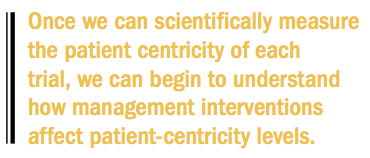
centricity of our trials, but will also provide a scientific basis for improving its role and clinical trials overall. Once we can measure the patient centricity of each trial, we can begin to understand how management interventions affect patient centricity levels, and provide a scientific foundation on which patient centricity can continue to develop and grow. But this vision all depends on a valid and reliable measurement. Preventing patient centricity from becoming a fad all boils down to scientific measurement of its ultimate impact.
Patient centricity is a complex construct with a multifaceted sampling process. Despite these challenges, however, it is still possible to develop a straightforward patient centricity measurement program. In this paper, we will describe how clinical trial managers can begin the journey to scientific measurement of patient centricity with a three-step process. These three steps are based on the standard processes from the peer-review psychometric literature.8 As a result, we provide a scientific, valid, and reliable approach to measuring patient centricity.
Patient centricity in a clinical trial means designing and conducting a study-including the care of patients within the trial-in way that is respectful of and responsive to patient preferences, needs, and values, and ensuring that patient values guide all decisions within the trial.9 We recognize three important implications in this definition. First, patient centricity measurement is a component of clinical trial quality. Clinical
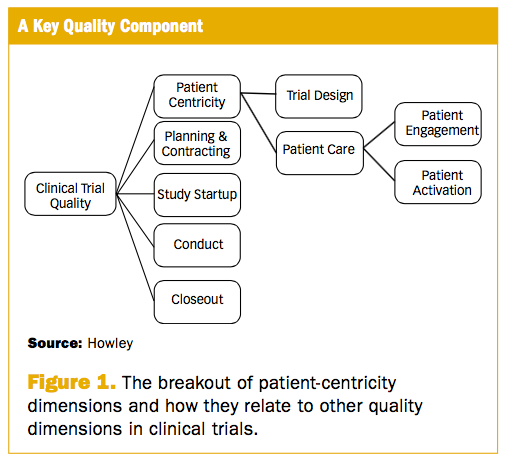
trial quality refers to the overall excellence or superiority of the trial. We have previously defined quality and discussed at length in a previous article, “The Quality of Clinical Trials.”10 Responding to patients is an important aspect of clinical trial quality.10,11,12 One can’t understand the quality of a clinical trial without measuring patient centricity, as shown in Figure 1.
The second implication of this definition of patient centricity is that measurement must also include the backstage activities of planning and designing the trial. To what degree are patients included in decisions about the research question, inclusion criteria, endpoints, marketing materials, recruitment, data collection, and dissemination of the study results? Measuring patient centricity, as a result, requires assessment at two levels: a high-level perspective on the design of the trial and then individual-level evaluations of patient care. At both levels, we use purposive sampling techniques-not random sampling-to assess the right respondent at the right time. All of this makes for a complex sampling process.
The third implication of this definition is that patient-centricity measurement also includes assessing the patient care aspects within the trial. Even though a clinical study is an experiment, it still involves caring for patients. It is important to include these care processes in patient-centricity measurement even though it is still a clinical trial.
One of the unique features of patient care is that both the provider and the patient have to collaborate in order to deliver effective care. Each has an important role in both the patient care side and the clinical trial activities. Providers, for their part, must be responsive to patients’ preferences, needs, and values. Patient engagement refers to patients assessing providers as to how well the provider cared for them in a way that was respectful and responsive to their preferences, needs, and values.13 Second, patients must be willing and able to do their part in the trial. Patient activation assesses how well subjects performed their role in the trial.13 Patients must have the knowledge, skills, and motivation to not only manage their health condition but also effectively participate in the trial protocol. Patient-centered medical care, then, is a relational construct in which providers engage patients but subjects also accept responsibility for their role in the care process.
Given this definition and implications, we offer a three-step process that trial managers can use to measure patient centricity.
Step 1: Get patient feedback
The first step in developing scientific patient-centricity measurement is to gather patient feedback about the trial. The critical success factor in this activity is to collect the right data. Many managers already gather feedback, for example, on patients’ satisfaction in their trials, and feel like they are measuring patient centricity. But patient centricity is not satisfaction-they are different constructs.15 Collecting unrelated data or undisciplined sampling adds inefficiency, is a waste of money, adds unnecessary complexity to the analysis, and generates biased information that obscures managerial judgment.
Start your patient feedback program by collecting data on patient engagement (i.e., how responsive the providers were to patients’ needs, values, and preferences) and patients’ perceptions of the quality of the trial. There are established, valid, and
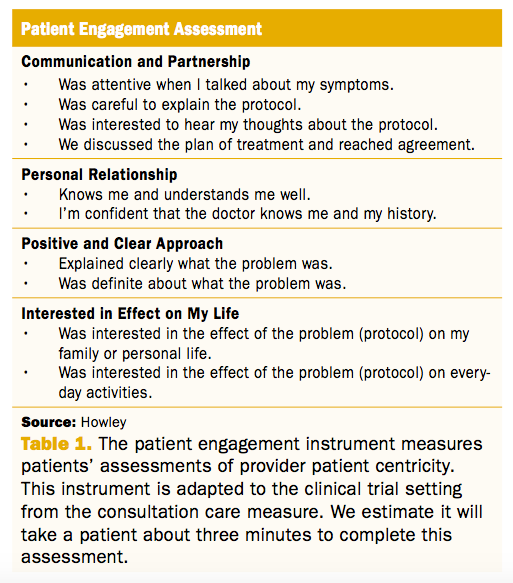
reliable instruments that clinical teams can use to measure both patient engagement and quality. After reviewing the available instruments,16 we felt that the consultation care measure had the highest face validity for measuring patient engagement in clinical trials, described in Table 1.17,18
It is also important to include patients’ perceptions of the quality of the study. Since the overall service quality will influence the patient-centricity scores, it is important to know the quality of the trial in order to assess the patient centricity in an unbiased way. We recommend SERVQUAL to measure the quality of the clinical trial.10 The SERVQUAL instrument, shown in Table 2, has been in use for more than 25 years.19,20 The tool has been tested across multiple industries and has consistently been valid and reliable. Use established, well-accepted instruments like
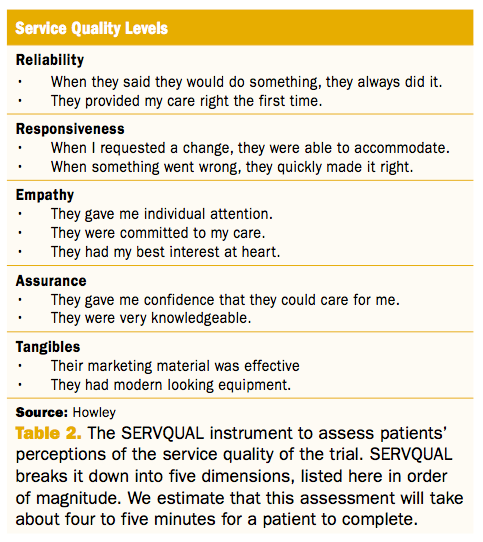
SERVQUAL to gather your data whenever possible. Why go through all the work of validating a new instrument when a precision instrument like SERVQUAL is available?
Patient engagement and service-quality data would typically be collected at the end of the study in order to understand how variations in patient engagement or quality affects the trial outcomes. Our goal in collecting this data, however, is to improve the quality of a current trial, not just subsequent studies. With that objective in mind, it is more useful to measure patient perceptions early in the trial (while still allowing the patient time to form an assessment), and then periodically throughout the trial. For the first assessment, the patient should have several contacts with the site or provider. After that, the intervals will depend on how often the patient is being seen. Trial participants should not be assessed more than quarterly, and stretching out the intervals will reduce the burden on patients. This approach of multiple assessments will create technical problems (i.e., auto-correlation) for the analysts, but these can be addressed in discussions with your statistical analysts.
Step 2: Assess the trial design
Patient-centricity measurement also includes an evaluation of the trial design. There are no established instruments available for assessing trial design. New assessments will need to be validated to provide scientific measurement. Fortunately, the Patient Centered Outcomes Research Institute (PCORI) has already done the groundwork of identifying all of the topics and issues that should
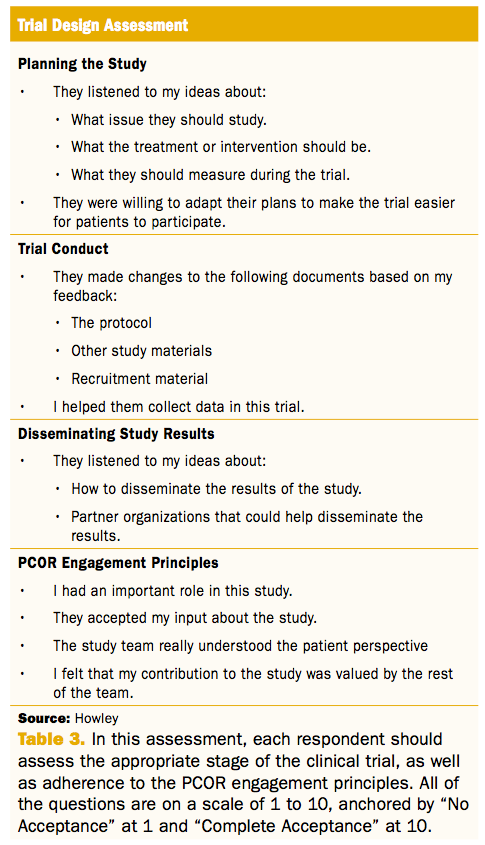
be addressed within the trial-design assessment.21 In this section, we operationalize those rubrics into an instrument that can then be validated, as shown in Table 3. The rubric includes four components: planning the study, conducting the study, disseminating the study results, and adherence to the PCORI engagement principles. There are two groups that should be sampled for the trial-design assessments: patients and partners. Partners include family members, caregivers, and patient advocacy organizations.21 While it is permissible to get evaluations from individuals who have multiple roles (e.g., they are a patient in a clinical trial as well as an advocate for the cause), the sample should not rely entirely on partners with multiple roles.
The planning-the-study assessment evaluates the degree to which patient partners are included in the conception and development of the trial. How much of a voice did patient partners have in identifying the topic, developing the research questions, and selecting the comparators to be studied? How much input did patient partners have in defining the characteristics of study participants? Finally, were the patient partners able to offer advice on how to minimize disruption to patients and incorporate study activities into their stream of activities for ongoing care? This data should be collected as the trial planning is finishing and the study is about to begin.
The conducting-the-study section involves measuring the degree to which patient partners participated in carrying out the study. Possible roles for the patients include participating in the drafting and revising trial materials or protocols, assisting with subject recruitment, assisting with data collection, or serving as a patient representative on a data safety monitoring board. This assessment should be timed to be administered as patients are completing the trial.
The disseminating-the-study-results unit evaluates the degree to which patient partners help identify partner organizations for dissemination, planning dissemination efforts, or even participating in the dissemination (e.g., co-authoring an article or co-presenting at a conference). These data can be collected shortly after the initiation of the dissemination phase, since patients will have formed an impression about their involvement early in dissemination.
Each of these three areas involve a specific stage of the trial. The fourth instrument assesses adherence to Patient-Centered Outcomes Research (PCOR) Engagement Principles (hereafter, “PCOR Principles”). The PCOR Principles include reciprocal relationships, co-learning, partnerships, trust, transparency, and honesty. Reciprocal relationships refer to the degree to which patient and stakeholder partners are considered key personnel and the degree to which they have decision-making authority in some areas. Co-learning refers to the degree to which patient and stakeholder partners understand the research process and the level to which the research team understands the patient and stakeholder perspectives. Partnership is the degree to which the contributions of the patient and stakeholder partners are valued. Trust, transparency, and honesty means that information is shared readily with the patient and stakeholder partners and they are included in decision-making. This open and honest communication extends from within the research team to the community being studied. The PCOR Principles assessment should be completed whenever any of the stage-specific assessments are administered.
Step 3: Assess patients
Patients have to do their part in order for a trial to be considered patient-centric. The degree to which patients are able, willing, and motivated to do their part in a clinical trial is called patient activation.14 The first part of patient activation is a self-assessment completed by the study participant. The Patient Activation Scale is a valid and reliable instrument to assess patients’ perceptions of their own
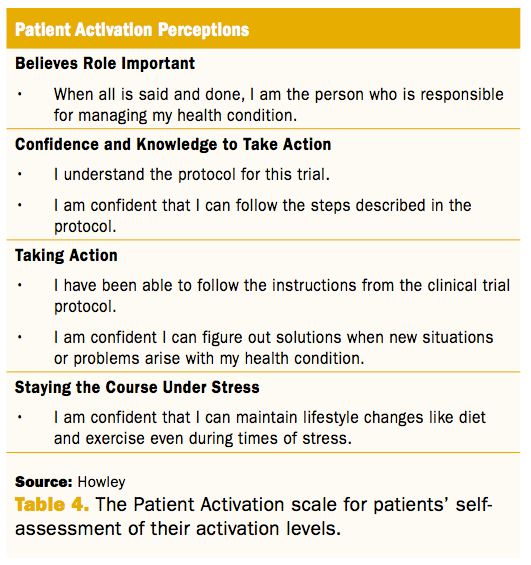
activation levels (see Table 4). The scale breaks out into four different dimensions: believes role is important, confidence and knowledge to take action, taking action, and staying the course under stress.14 The “believes-role-is-important” dimension assesses whether the patient recognizes that they have a role. The “confidence-and-knowledge-to-take-action dimension” measures how able the patient is at taking the initial actions in following the protocol and caring for their health condition. The “taking-action” dimension shifts the perspective from potential ability to the patients’ ability to execute the plan. But patients must also be able to persevere with executing their plan, which is measured by the “staying-the-course-under-stress” section.
We recommend that patient activation be measured at the start of the trial as a baseline and then periodically across the duration of the study. The initial activation scores can be used to identify patients with low activation who would benefit from an intervention to improve their activation levels.22 How activation changes over the course of the trial will reflect the impact of the clinical site and

provider interactions with the patient.
Self-reports of patient activation may be influenced by social desirability bias.23 To offset this issue, we recommend that providers also assess patients using the Physician Assessment of Patient scale, shown in Table 5.24 We have adapted these items not only for the clinical trial context, but also to facilitate comparison with the Patient Activation scale.
Discussion
While there are challenges to measuring patient centricity, we have described a straightforward three-step process that managers can use to begin their patient-centricity measurement programs. It is important to realize that most of the challenges lie in the sampling process. Getting the right instrument to the right person is the challenge, but can be expedited with cloud-based administrative technologies.
As you begin to gather patient-centricity assessments, it is worth considering how your organization will act on the feedback. If patients are

taking the time to offer feedback, they will expect a response or some action to their input. Will your organization be able or willing to adapt their clinical trial process to what patients want? Recognize that, at a fundamental level, patient centricity is about power. How much will you let patients dictate what happens in a trial? Obviously it is an issue of balancing power, but this is new territory for the clinical trials industry.
Since patient centricity is a dimension of quality-a No. 1 implication of any clinical trial-then patient-centricity measurement should be integrated into an ongoing quality measurement program. Patient centricity should be thought of as an integral component of overall quality and not measured in a vacuum. We have described the scientific way to measure clinical trial quality in previous articles.10,25,26
It is important that patient centricity not be assessed with operational metrics. While operational metrics can be “easy data,” they lack validity, which means they lack meaning. To illustrate this problem, we have heard it suggested that the amount of time it takes a site to enter data can be used as a patient-centricity indicator. The rationale is that the more the clinician is focused on their patient, the more inclined they will be to enter the data as soon as the visit is completed. But what if the clinician is spending a tremendous amount of time responding to patient needs, preferences, and values? They are likely to be delayed in entering data while responding to these patient needs. This is the type of problem you get into with operational metrics. It becomes difficult to assign a rational meaning, even though the data is readily available.
Note that many of the items described here are leading indicators, allowing managers to identify and intervene on impending failures. This means that one of the consequences of this measurement program will be to improve the patient centricity of clinical trials.
It should be clear from this article that measuring patient centricity is not easy. It takes a lot of work in order to measure patient centricity in a way that meets scientific standards. It is worth considering the potential returns from these patient-centricity measurement investments. Since there is no widespread scientific measurement, we can only speculate about a potential ROI on measuring patient centricity. Since other authors have argued elsewhere about the ethical and patient care benefits,27 we will focus on the other potential returns.
The most common reason for denying new drug applications (NDAs) include issues with the selection of trial subjects and the lack of meaningful or relevant endpoints.28 As a result, measuring and then improving the patient centricity of the trial design should enhance the ability to get drug approval. Measuring and improving the patient centricity of the patient care aspects of the trial should enhance site functioning, enhance patient retention, and improve patient recruitment. Finally, patient-centric trials will better illustrate the value of the investigational drug to patients and enhance the ability to get reimbursement on the compound if it reaches the market.
Conclusion
Patient centricity is an important and necessary development that has the potential to improve the quality, relevance, and value of clinical trials. We are concerned about the perceptions that patient centricity is drifting toward being perceived as a fad. To prevent this from happening, it is important that we begin to measure and manage patient centricity in a valid, reliable, and scientific way. It is critical that we get this right. Patient centricity plays a too-important role in today’s drug development model to allow it to become a fad.
References
1. K.A. Getz, “The Transformative Promise of Patient Centric R&D,” Pharmaceutical Business Review, May 7, (2015), http://clinicaltrials.pharmaceutical-business-review.com/news/the-transformative-promise-of-patient-centric-rd-070515-4571105
2. R. Wright, “How to Build Real Patient Pharmaceutical Companies,” Clinical Leader, October 15, (2014), http://www.lifescienceleader.com/doc/how-to-build-real-patient-centered-pharmaceutical-companies-0001
3. S. Rocchio, “Patient-Centric Clinical Research: A Renaissance in the Making, Applied Clinical Trials, January 22, (2014), http://www.appliedclinicaltrialsonline.com/patient-centric-clinical-research-renaissance-making
4. A fad is defined as a desirable trend characterized by initial enthusiasm and energy over a short period of time that quickly fades away. Adapted from Merriam-Webster Dictionary at http://www.merriam-webster.com/dictionary/fad.
5. T. Kole, “Patient-Centric Clinical Trials: Fad, Trend, or Future?” Pharma Voice, June (2012), http://www.almacgroup.com/wp-content/uploads/Patient-Centric-Clinical-Trials-Fad-Trend-or-Future.pdf, pg 78.
6. P. Ivsen, “The Patient Centricity “Fad” and the Token Patient,” eyeforpharma, July 30, 2014, http://social.eyeforpharma.com/clinical/patient-centricity-fad-and-token-patient
7. For the characteristics of business fads, see J. Hartwick, and D. Miller, “Spotting Management Fads.” Harvard Business Review, 80 (10) 26-27 (2002).
8. For a review, see M. Furr, Scale Construction and Psychometrics for Social and Personality Psychology. SAGE Publications Ltd, 2011.
9. Institute of Medicine, Crossing the Quality Chasm, (2001) page 40.
10. M.J. Howley, and P.M. Malamis, “The Quality of Clinical Trials,” Applied Clinical Trials, January 13, (2015), http://www.appliedclinicaltrialsonline.com/quality-clinical-trials (accessed May 10, 2015).
11. M.J. Howley, and P.M. Malamis, “High Performing Study Startups,” Applied Clinical Trials, 23 (6), (2014), Also available at http://www.appliedclinicaltrialsonline.com/metrics-behind-high-performing-study-startups, (accessed May 10, 2015).
12. M.J. Howley, and P.M. Malamis, “Quality Drivers in Clinical Trial Conduct,” Applied Clinical Trials, July 14, 2015, http://www.appliedclinicaltrialsonline.com/quality-drivers-clinical-trial-conduct-0 (accessed June 20, 2015).
13. S. James, J. J. Hibbard, T. Agres, R. Lott, and S. Dentzer. “Health Policy Brief: Patient Engagement.” Health Affairs (2013) 33 (6).
14. J.H. Hibbard, et al. “Development of the Patient Activation Measure (PAM): Conceptualizing and Measuring Activation in Patients and Consumers,” Health Services Research (2004) 39 (4) 1005-1026.
15. J.M. Kupfer and E.U. Bond, “Patient Satisfaction and Patient-Centered Care: Necessary But Not Equal.” JAMA, 308 (2), 139-140 (2012).
16. For a review of patient centeredness instruments, see C. Hudson, M. Fortin, J. Haggerty, , M. Lambert, and E.M. Poitras, “Measuring Patients’ Perceptions of Patient-Centered Care: A Systematic Review of Tools for Family Medicine, Annals of Family Medicine, 9 (2) 155-164 (2011).
17. Despite the name, this assessment provides good measurement of the patient engagement construct. There is a lot of confusion in patient-centricity terminology-both in the managerial and academic sectors.
18. P. Little, H. Everitt, I. Williamson, G. Warner, et. al. “Observational Study of Effect of Patient Centredness and Positive Approach on Outcomes of General Practice Consultations.” BMJ, 323 (7318) 908-911 (2001).
19. A. Parasuraman, V.A. Zeithaml, and L.L. Berry, “SERVQUAL: a Multiple-Item Scale for Measuring Consumer Perceptions of Service Quality.” Retailing: Critical Concepts 64 (1) 140-148 (2002).
20. A. Parasuraman, L.L. Berry, and V. A. Zeithaml, “Refinement and Reassessment of The SERVQUAL Scale, Journal of Retailing, 67 (4), 420-426 (1991).
21. PCORI Engagement Rubric. patient centricityORI (Patient-Centered Outcomes Research Institute),
http://www.pcori.org/sites/default/files/Engagement-Rubric.pdf. Published February 4, 2014. Updated June 29, 2015. Page 2.
22. J. Hibbard, J. Greene, V. Overton, “Patients with Lower Activation Associated with Higher Costs; Delivery Systems Should Know Their Patients’ Scores,” Health Affairs, (2013) 32 (2), 216-222.
23. R.J. Fisher, and J.E. Katz. “Social-desirability Bias and the Validity of Self-Reported Values,” Psychology & Marketing, 17, 105-120 (2008).
24. D.H. Thom, S.T. Wong, D. Guzman, A. Wu, et. al. “Physician Trust in the Patient: Development and Validation of a New Measure.” The Annals of Family Medicine 9 (2), 148-154 (2011).
25. M.J. Howley and P.M. Malamis “Clinical Trial Performance Measures You Can Use (and believe)”, Clinical Leader, (2013)October, http://www.outsourcedpharma.com/doc/clinical-trial-performance-measures-you-can-use-and-believe-0001
26. MJ Howley and P.M. Malamis (2014) Metrics Malpractice, Applied Clinical Trials Online, Accessed June 23, 2015. Available at http://www.appliedclinicaltrialsonline.com/appliedclinicaltrials/Blogs/How-We-Fall-into-Metrics-Malpractice/ArticleStandard/Article/detail/844223?contextCategoryId=49914
27. D.M. Berwick, “What ‘Patient-Centered’ Should Mean: Confessions of an Extremist.” Health Affairs (2009) 28(4), w555-w565.
28. L.V. Sacks, H.H. Shamsuddin, Y.I. Yasinskaya, K. Bouri, et. al. “Scientific and Regulatory Reasons for Delay and Denial of FDA Approval of Initial Applications for New Drugs, 2000-2012.” JAMA (2014) 311(4) 378-384.
Michael J. Howley, PA-C, PhD, is Associate Clinical Professor, LeBow College of Business, Drexel University, email: mikehowley@drexel.edu; Peter Malamis, MBA, is CEO, CRO Analytics, LLC, email: pmalamis@croanalytics.com
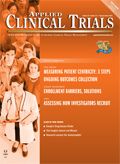
Accelerating Clinical Trial Design and Operations
Fully-integrated, component-based CDMS offers flexibility, customization, and efficiency.